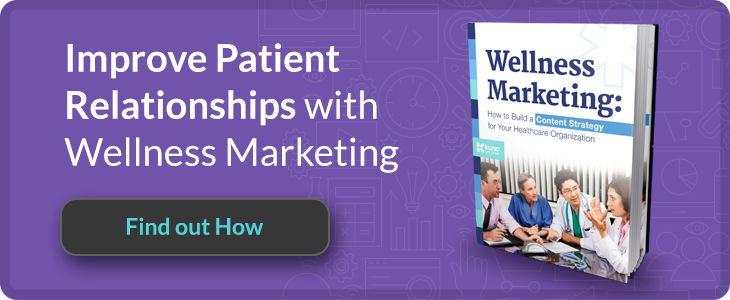
How to Create Irresistible Health and Wellness Content

 Do you make a mad dash for the Internet every time you encounter a sniffle or cough? Google says you’re not alone.
Do you make a mad dash for the Internet every time you encounter a sniffle or cough? Google says you’re not alone.
One in 20 searches on the site is for health-related information, the search giant reports. Given there are more than 1 billion searches performed on Google each day, that means there are about 200 million health-related searches entered every 24 hours.
Let’s marinate on that for a moment. ... 200 million. That’s more than the number of dollars Beyonce made in 2014.

There’s no denying the demand for health and wellness information is astounding, but are healthcare businesses delivering? If you think WebMD already has the market cornered, think again. With so many searches taking place each day, there is plenty of opportunity for your brand to carve out its rightful spot in the health and wellness content world.
If your healthcare business doesn’t have a well-developed content strategy, you’re missing out on an enormous opportunity. Today, we’re going to change that.
Let’s talk about some ways your business can increase visibility, enhance credibility, earn new customers and improve your readers’ quality of life using irresistible content.
Find Your Niche
One of the most important pieces of advice for creating powerful health and wellness content is to not to bite off more than you can chew. That is, stay focused on your area of expertise. If you’re a podiatrist, for example, don’t waste time writing about seasonal allergies because it’s not what your current or prospective patients expect you to know.
Consider MyFitnessPal. The popular calorie-counting and fitness-tracking app dedicates its blog Hello Healthy to sharing trustworthy, credible content most relevant to its readers: articles on exercise written by athletes and personal trainers, nutritional recipes by licensed dietitians and motivational success stories from verified app users. By sticking to what they know, MyFitnessPal has become a trusted resource in diet and exercise—which lends credibility to its app.

Consult Your Data
What do people want to read? To answer this question, you should take a look at your qualitative and quantitative data.
- Qualitative: Interview a few of your customers or patients who best align with your primary buyer persona, and ask them what challenges they face and what sorts of topics they research online most. If you sell a B2B or B2C product, consult your sales team to determine the most common questions asked during the buyer’s journey.
- Quantitative: Pull keyword reports and search engine query reports to determine how many people are searching specific words and phrases. What keywords do you currently rank for, and what would you prefer to rank for in the future? (For assistance on keyword research, check out this blog post by Kissmetrics.)
By focusing your content around these keywords, phrases and common questions, you will improve search ranking and, more importantly, help customers and patients get the answers they seek.
Stay on Top of Trends
The Internet loves trends, especially when it comes to health and wellness topics. There’s no shortage of advice and, unfortunately, much of it originates from people with no medical education or professional training. From something as harmless as curing acne with toothpaste to something as dangerous as foregoing vaccinations based on unproven claims, misinformation is rampant in the medical content world.
This is one of the few times I can say “content marketing is a matter of life and death” without being hyperbolic and dramatic. (In the marketing world, we don’t get to say that very often and actually mean it.) Content marketing allows you the opportunity to set the record straight using facts, figures and your own professional knowledge. Addressing fads will not only help reduce the number of misinformed consumers, it also helps enrich your content’s SEO value.
In light of recent debates about mental illness, gun control and violence, Aetna weighed in with facts from a leading expert. This information helped address the misconception that people suffering from mental illness are often violent and dangerous.

Tell Stories
How many times have you heard the term “storytelling” in relation to content? In the past, we’ve talked a lot about why stories are important and how to incorporate storytelling into your marketing. That’s because stories are one of the best possible ways any business can share information. When it comes to health and wellness content, stories can make a major impact on the way readers respond to your brand.
Take the Mayo Clinic, for example. The organization’s blog Sharing Mayo Clinic publishes stories from the staff’s patients, family and friends. By sharing these stories like the video below, the hospital does three things:
- It connects people to the brand on an emotional level—like the video.
- It helps convey the clinic’s successes in a way that adds credibility and trust.
- It validates people's health issues, making them feel that they're not alone in their experiences.
Conclusion
Of course, you don’t have to be an organization the size of Mayo Clinic or Aetna to create powerful content people will want to consume—you just need a well-planned strategy, experts willing to weigh in and a commitment to make a difference. By applying the suggestions above, you can begin building your stockpile of irresistible content and become an authority consumers trust.


